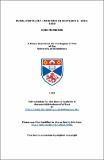Files in this item
Rural nostalgia : painting in Scotland c.1860-1880
Item metadata
| dc.contributor.advisor | Spencer, Robin | |
| dc.contributor.author | Morrison, John | |
| dc.coverage.spatial | 545 | en_US |
| dc.date.accessioned | 2015-04-15T12:34:39Z | |
| dc.date.available | 2015-04-15T12:34:39Z | |
| dc.date.issued | 1989-06 | |
| dc.identifier | uk.bl.ethos.341615 | |
| dc.identifier.uri | https://hdl.handle.net/10023/6481 | |
| dc.description.abstract | A work of "rural nostalgia" is a distorted image of a past, or passing rural existence produced in the period c.1860-1880. It is distorted in such a way as to heighten the emotional impact of the work and to emphasize the inherent moral message carried by the painting. This message is always the same. In precisely the same terms as contemporary commentators, the painters lauded those aspects of human existence thought to be essential for a humane civilised society and felt to be being destroyed by the urbanisation of man. Hence family life, the home and community life were praised. Along with individual human relationships, society's provision of both temporal and religious education were seen as vital. These linked factors, so prevalent in rural life. were thus also frequently portrayed, praised and give an implicitly rural setting. The ambivalent response to their industrial society of mid-Victorian Scots. themselves engaged in commerce and industry, found expression in the work of artists such as G.P. Chalmers and George Reid. In effect the collectors of rural nostalgia. convinced of the educative role of art, sought to promote a more responsible, caring, society through their purchasing and subsequent lending out of rural nostalgia paintings. The paintings themselves. though heavily imbued with the spirit of contemporary Calvinist Scotland, were philosophically influenced by John Ruskin and by French "Realist" writing and criticism. They were practically influenced by nineteenth century Dutch painting. The significance of the painters of rural nostalgia lies not in their formal innovations, though they were technically of considerable importance to the later "Glasgow School", it lies in the alternative view they afford of the motivations and concerns of the patrons and practitioners of painting in Scotland in the third quarter of the nineteenth century. | en_US |
| dc.language.iso | en | en_US |
| dc.publisher | University of St Andrews | |
| dc.subject.lcc | ND478.R8M7 | |
| dc.title | Rural nostalgia : painting in Scotland c.1860-1880 | en_US |
| dc.type | Thesis | en_US |
| dc.type.qualificationlevel | Doctoral | en_US |
| dc.type.qualificationname | PhD Doctor of Philosophy | en_US |
| dc.publisher.institution | The University of St Andrews | en_US |
This item appears in the following Collection(s)
Items in the St Andrews Research Repository are protected by copyright, with all rights reserved, unless otherwise indicated.

